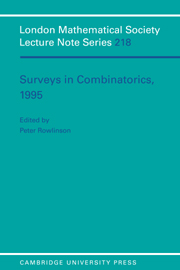Book contents
- Frontmatter
- Contents
- Preface
- Euclidean geometry of distance regular graphs
- Large sets of Steiner triples
- Searching with lies
- Spin models for link invariants
- Computational Pólya theory
- Mixing of random walks and other diffusions on a graph
- Cayley graphs: eigenvalues, expanders and random walks
- Construction and classification of combinatorial designs
- Modern probabilistic methods in combinatorics
Spin models for link invariants
Published online by Cambridge University Press: 05 May 2010
- Frontmatter
- Contents
- Preface
- Euclidean geometry of distance regular graphs
- Large sets of Steiner triples
- Searching with lies
- Spin models for link invariants
- Computational Pólya theory
- Mixing of random walks and other diffusions on a graph
- Cayley graphs: eigenvalues, expanders and random walks
- Construction and classification of combinatorial designs
- Modern probabilistic methods in combinatorics
Summary
INTRODUCTION
The discovery by Vaughan Jones in 1984 of a new polynomial invariant of links was the starting point of spectacular advances in knot theory which suddenly brought together previously unrelated concepts from various branches of mathematics and physics. One particularly fruitful idea was to consider a link diagram as an abstraction of a physical system of elementary objects (molecules, atoms, particles…) interacting in a local fashion. These local interactions are described by a statistical mechanical model. In the context of physics, much of the relevant information is then given by the partition function. The basic facts from the point of view of knot theory are that one can define natural conditions on the parameters of the model which insure that the partition function is a link invariant, and that one can actually find models satisfying these conditions which yield non-trivial link invariants. In fact, the models which correspond to link invariants are closely related to the exactly solvable or integrable models which are of particular interest in physics.
We shall be mainly concerned here with the version of this approach to the construction of link invariants which is based on spin models. There the local interactions can be viewed as taking place between the vertices of a graph and along the edges of this graph. The simplest case is that of the Potts models, which give rise in the context of graph theory to the Tutte polynomial, and in the context of knot theory to the above mentioned Jones polynomial. Spin models for link invariants can be defined in terms of matrices satisfying certain equations.
- Type
- Chapter
- Information
- Surveys in Combinatorics, 1995 , pp. 71 - 102Publisher: Cambridge University PressPrint publication year: 1995
- 1
- Cited by



